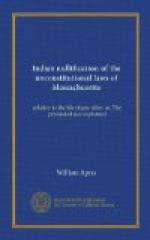In 1763, Marshpee was incorporated as a District, including the land now called the parsonage. “Be it enacted, &c. that all the lands belonging to the Indians and mulattos in Mashpee be erected into a district, by the name of Mashpee.” The Proprietors are empowered to meet “IN THE PUBLIC MEETING HOUSE,” [the one now claimed by Mr. Fish,] to elect a Moderator, five Overseers, two to be Englishmen, a town Clerk and Treasurer, being Englishmen, two Wardens, and one or more Constables. The majority of the Overseers had the sole power to regulate the fishery, to lease such lands and fisheries as are held in common, not exceeding for two years, and to allot to the Indians their upland and meadows. This act was to continue for three years and no longer. It does not appear ever to have been revived. The revolutionary war intervened, and there is no act after 1766, until the act of 1788, after the revolutionary war, which last act put the Indians and their lands under strict guardianship.
In this interval between 1766 and 1788, the only transaction on which Mr. Fish can found any claim to the parsonage look place. There was then either no law existing, which could empower any person to sequester and set apart the lands of the Indians, or the law of 1693, (if that of 1763 had expired,) was revived, by which the guardianship again attached to the Indians. The Indians, it is believed, continued to choose their own Overseers, under the charter of 1763, after it had expired, and without any authority to do so. It was the only government they had during the troubles of the revolution.
We now come to the first evidence of any thing relating to the parsonage land being set apart from the common land. This was in 1783, and the following is the Deed from the Records of Barnstable County, and the only deed relating to this property.
DEED OF MARSHPEE PARSONAGE.
Know all Men by these Presents, That we, Lot Nye, Matthias Amos, Moses Pognet, Selectmen, and Israel Halfday, Joseph Amos and Eben Dives, of the district of Marshpee, for the support of the Gospel in said Marshpee in all future generations, according to the discipline and worship of the Church in this place, which is Congregational, do allot, lay out, and sequester forever, a certain tract of land, being four hundred acres more or less, lying within the Plantation of Marshpee, and being Indian property, which is to lay as a parsonage forever and to be improved and used for the sole purpose aforesaid; and the said tract or parcel of land for the said Parsonage, is situated on the East side of Marshpee river, and bounded as follows, viz: Beginning at a certain spring of fresh water which issues from the head a small lagoon on the East side of Marshpee river aforesaid, and runs into said river a small distance below, and South of the spot where negro Scipio and his wife Jemimai had their house, which is now removed, and from




